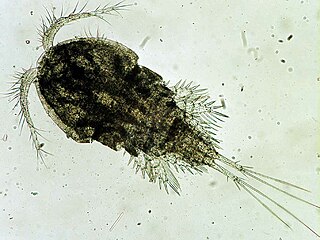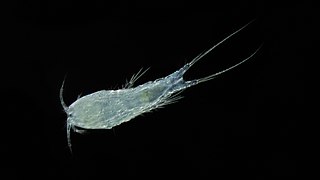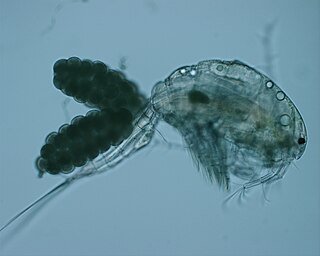
Calanus is a genus of marine copepod in the family Calanidae. The genus was split in 1974, with some species being placed in a new genus, Neocalanus. The following species are recognised:

Cyclops is one of the most common genera of freshwater copepods, comprising over 400 species. Together with other similar-sized non-copepod fresh-water crustaceans, especially cladocera, they are commonly called water fleas. The name Cyclops comes from the Cyclops of Greek mythology, as they have a single large eye; in Cyclops, the eye may be either red or black.

Diaptomus is a genus of copepods with a single eye spot. It is superficially similar in size and appearance to Cyclops. However it has characteristically very long first antennae that exceed the body length. In addition, the females carry the eggs in a single sac rather than the twin sacs seen in Cyclops. It is a copepod of larger freshwater ponds, lakes and still waters.

Canthocamptus is a genus of copepods that live in freshwater of Holarctic. There are 21 different species of Canthocamptus.
Acanthocyclops is a genus of copepod crustaceans in the family Cyclopidae. It was originally described by Friedrich Kiefer as a subgenus of Cyclops, and contains the following species:
Afrocyclops is a genus of copepod crustaceans in the family Cyclopidae, containing the following species:
Heliodiaptomus is a genus of copepods in the family Diaptomidae, containing the following species:.

Mesocyclops is a genus of copepod crustaceans in the family Cyclopidae. Because the various species of Mesocyclops are known to prey on mosquito larvae, it is used as a nontoxic and inexpensive form of biological mosquito control.
Metacyclops is a genus of copepod crustaceans in the family Cyclopidae, containing 61 species, of which three are listed on the IUCN Red List – M. campestris from Brazil, M. gasparoi from Italy (vulnerable) and M. postojnae from Slovenia (vulnerable).
Metadiaptomus is a genus of crustacean in the family Diaptomidae, containing the following species:
Neodiaptomus is a genus of freshwater copepods in the family Diaptomidae. It contains the following species, four of which are listed as vulnerable species on the IUCN Red List :
Notodiaptomus is a genus of copepods in the family Diaptomidae. It is the most widely distributed, most abundant and most species-rich genus of freshwater calanoid copepods in the Neotropics. The genus was erected in 1936 by Friedrich Kiefer for eleven species formerly placed in a wider Diaptomus. Notodiaptomus deitersi was chosen to be the type species by Raúl Adolfo Ringuelet in 1958.
Thermodiaptomus is a genus of copepods in the family Diaptomidae, containing the following species:

Diaptomidae is a family of freshwater pelagic copepods. It includes around 50 genera:

The Cyclopidae are a family of copepods containing more than half of the 1,200 species in the order Cyclopoida in over 70 genera.
Afrocyclops gibsoni is a species of copepod in the family Cyclopidae. Three subspecies have been identified:
Megacyclops is a genus of copepods, containing the following species:

Cyclops bicuspidatus is a planktonic species of copepod found throughout the world, except Australia, and characteristic of the Great Lakes of North America. It is a deep water species found throughout the year with peak abundance occurring in May or June. Males grow up to 0.8–1.0 millimetre (0.031–0.039 in) long, while females are larger at 0.9–1.6 mm (0.035–0.063 in).
Halicyclops is a genus of copepods belonging to the family Cyclopidae. There are currently 94 described species found in brackish habitats throughout the world:
Microcyclops is a genus of copepods, containing the following species:







